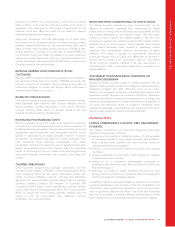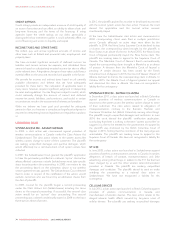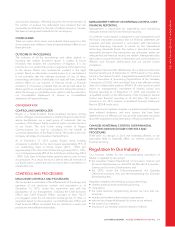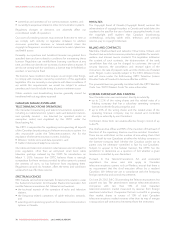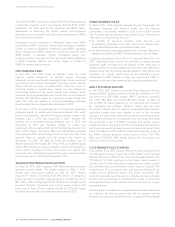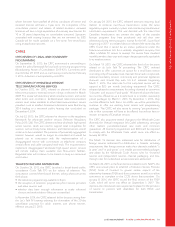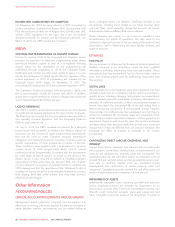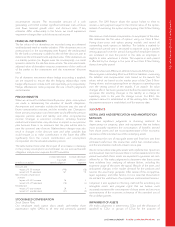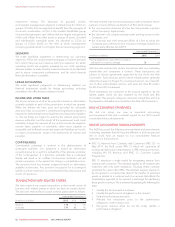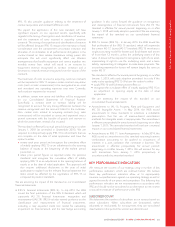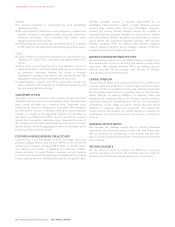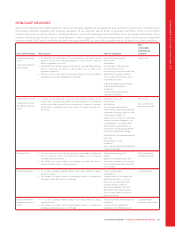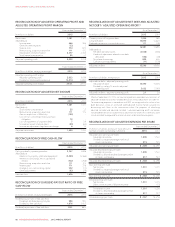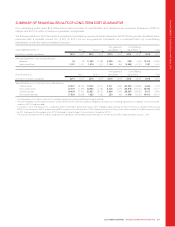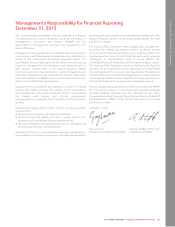Rogers 2015 Annual Report Download - page 81
Download and view the complete annual report
Please find page 81 of the 2015 Rogers annual report below. You can navigate through the pages in the report by either clicking on the pages listed below, or by using the keyword search tool below to find specific information within the annual report.
MANAGEMENT’S DISCUSSION AND ANALYSIS
where licensees have satisfied all of their conditions of licence and
renewed licences will have a 1-year term. On completion of the
consultation process and release of related decisions, renewed
licensees will have a high expectation of receiving new licences for
10 or 20 years (depending on consultation outcome). Spectrum
associated with existing licences that are not renewed by ISED
Canada will be made available on a first-come, first-served basis
using an application process.
CABLE
CRTC REVIEW OF LOCAL AND COMMUNITY
PROGRAMMING
On September 14, 2015, the CRTC announced a proceeding to
review the policy framework for local and community programming
(Broadcasting Notice of Consultation 2015-421). Comments were
due October 29, 2015 and an oral hearing concluded on February
3, 2016. A decision is anticipated by mid-2016.
CRTC REVIEW OF WHOLESALE WIRELINE
TELECOMMUNICATIONS SERVICES
In October 2013, the CRTC initiated its planned review of the
telecommunications essential services rulings it released in March
2008. The review will determine which wireline services, and under
what terms and conditions, facilities-based telecommunications
carriers must make available to other telecommunications service
providers, such as resellers. Extensive submissions were filed during
2014 leading to a two-week public hearing that concluded on
December 4, 2014.
On July 22, 2015, the CRTC released its decision on the regulatory
framework for wholesale wireline services (Telecom Regulatory
Policy 2015-326). The CRTC determined that wholesale high-speed
access services, which are used to support retail competition for
services, such as local phone, television, and Internet access, would
continue to be mandated. The provision of provincially aggregated
services, however, would no longer be mandated and would be
phased out in conjunction with the implementation of a
disaggregated service with connections at telephone company
central offices and cable company head-ends. The requirement to
implement disaggregated wholesale high-speed access services
will include making them available over fibre-access facilities.
Regulated rates will continue to be based on long-run increment
cost studies.
TELEVISION SERVICES DISTRIBUTION
On October 24, 2013, the CRTC launched a broad-based public
consultation (“Let’s Talk TV”) on the subject of television. The
consultation covered three broad themes, asking what consumers
think about:
• the television programming available to them;
• the reception of television programming from service providers
and other sources; and
• whether they have enough information to make informed
choices and seek solutions if they are not satisfied.
In November 2014, the CRTC released its first decision arising from
the Let’s Talk TV hearing ordering the elimination of the 30-day
cancellation provision for cable, Internet, and phone services,
effective January 23, 2015.
On January 29, 2015, the CRTC released decisions requiring local
stations to continue over-the-air transmission under the same
regulatory regime currently in place and maintaining simultaneous
substitution requirements. This was decided with the intent that
Canadian broadcasters can protect the rights of the popular
foreign programs they have purchased and sell their own
advertising during these programs, except for the NFL Super Bowl
beginning in 2017. In a related decision released the same day, the
CRTC found that it would be an undue preference under the
Telecommunications Act for a vertically integrated company that
offers a Mobile TV service to exempt this service from standard
monthly wireless data caps and usage charges generally applicable
to its wireless service.
On March 19, 2015, the CRTC released the third of its decisions
related to its Let’s Talk TV proceeding. The CRTC ordered
distributors to offer customers an option for a small basic service
consisting only of Canadian local channels (local radio is optional),
national mandatory services, community and provincial legislature
channels, and, should they wish, US 4+1 networks beginning
March 1, 2016. The retail rate for this entry-level service will be
capped at $25 per month (excluding equipment). The CRTC
adopted phased-in requirements for selling channels to customers
“à la carte” and as part of “pick-packs”. All channels above the basic
tier must be offered on an à la carte basis or in smaller, reasonably
priced packages by March 1, 2016. By December 1, 2016, they
must be offered in both forms. As a BDU, we will be permitted to
continue to offer our existing basic service and programming
packages. The CRTC will also revise its existing “preponderance”
rule so that consumers will have to be offered, but will not have to
receive, a majority of Canadian services.
The CRTC also proposed several changes to the Wholesale Code
(formerly the Vertical Integration (VI) Code) addressing, amongst
other matters, penetration-based rate cards and minimum
guarantees. All licensed programmers and BDUs will be required
to comply with the Wholesale Code, which came into effect on
January 22, 2016.
The March 19 decision also addressed rules for distribution of
foreign services authorized for distribution in Canada, including
requirements that foreign services make their channels available “à
la carte” and “in pick-packs” or in smaller pre-assembled packages
and abide by the Wholesale Code. Access rules for VI-owned
services and independent services, channel packaging, and buy-
through rules for multicultural services were also addressed.
On March 26, 2015, in the final decision related to Let’s Talk TV, the
CRTC announced plans to establish a Television Service Provider
(TVSP) Code of Conduct to govern certain aspects of the
relationship between TVSPs and their customers as well as to allow
consumers to complain to the CCTS about their providers. On
January 8, 2016, the CRTC issued the final version of the TVSP
Code, which will come into effect on September 1, 2017. This
decision also introduced new requirements related to the provision
of service to persons with disabilities for both BDUs and
broadcasters.
2015 ANNUAL REPORT ROGERS COMMUNICATIONS INC. 79






